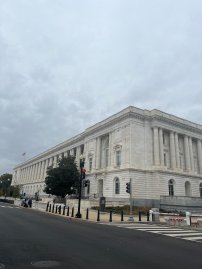Artikkelit

20.11.2024
Education, Science, and Ideology: Trump Administration and Federal Programs, Petri Koikkalainen
Science, technology, and higher education were not central themes in president-elect Donald Trump’s campaign. However, he did make several notable pledges, such as shutting down the Department of Education, protecting university students from the allegedly radical left-wing climate of the campuses, and redirecting funds from university endowments to establish an “American Academy” to compete with traditional four-year colleges. Trump’s positions on climate, energy, and China are also likely to impact federal science and technology policy and funding.
Change and continuity in S&T policy
The Trump administration’s approach to science policy could bring significant changes for universities and researchers reliant on federal funding, particularly in areas where political priorities shift, such as climate research or any field deemed to have an “ideological bias.” In addition to Trump, vice president-elect J.D. Vance has been a vocal critic of U.S. universities as they currently stand.
On the other hand, some major federally funded science and technology programs are expected to continue, including the Artemis Program for lunar and Mars exploration, the National Quantum Initiative, and the Bold Decadal Vision for Commercial Fusion Energy. The Artemis and Quantum programs began under Trump’s first term and continued through the Biden administration, while the fusion energy program, initiated in 2022, has received bipartisan support in Congress. These programs are seen as crucial to the U.S. national interest, supporting critical and often dual-use science and technology fields that can change the global balance of power.
A shift in Congressional power may also place a stronger emphasis on applied research and innovation, potentially at the expense of fundamental research, and on military and dual-use technology over purely civilian research. Economic and military competition with China is the likely justification for substantial new investments in these areas.
While Republicans have criticized the Biden administration’s R&D policies, including substantial investments in research and reindustrialization under the Inflation Reduction Act (IRA) and the CHIPS & Science Act, a complete rollback of these programs is unlikely. Much of the funding has already been allocated, with a significant portion directed to Republican-led states. Technology companies, research institutions, and regional political interests together form a strong lobby advocating for continued federal R&D investments in these states. However, the new Congress may seek to reduce or eliminate specific types of funding, such as for green energy initiatives or diversity, equity, and inclusion (DEI) programs.
A better-prepared Trump?
During Trump’s first administration from 2016 to 2020, overall federal R&D spending rose, despite intentions to reduce federal spending. Some agencies saw substantial budget increases, as the bipartisan science and tech lobby often succeeded in pushing initiatives through Congress. In his second administration, however, Trump may be more prepared to implement cost-cutting measures, and the appointment of Elon Musk and Vivek Ramaswamy to lead the new Department of Government Efficiency (DOGE) adds to the research community’s uncertainty.
It also remains unclear how Trump’s goal to “dismantle the Deep State” by firing “rogue bureaucrats” will impact science agencies. A broad replacement of program directors and experts—hired primarily for their scientific expertise—could significantly alter the mission and operations of federal science agencies. However, science agencies are not specifically targeted in policy documents like Trump’s Agenda47 or Project 2025, the latter developed by the conservative Heritage Foundation as a proposed blueprint for a future Trump administration.
Education and universities
Donald Trump has repeatedly pledged to abolish the U.S. Department of Education, aiming to transfer all educational authority to individual states. Unlike countries with centralized systems, such as Finland, the U.S. has a highly decentralized education system, and the Department of Education’s budgetary and steering powers are limited in comparison to Finland’s Ministry of Education and Culture. Nonetheless, dismantling the Department of Education could have significant effects. Key areas to watch include:
- Federal Funding for K-12 Education: Federal contributions are crucial for certain programs, especially in areas like special education for students with disabilities or special needs.
- Equal access to education: The department oversees equal access to education and the prohibition of discrimination. The future of federal programs including DEI elements is very uncertain at all levels of education from K-12 to universities. Changes could impact funding and support for disadvantaged minorities, gender education, and related initiatives.
- Student Financial Aid: As the largest provider of student aid in the U.S., the Department of Education oversees grants and loans, including Pell Grants for low- and middle-income students. The reach and structure of these programs could shift significantly, potentially changing the demography of the student body.
Critics argue that federal education funding will still require oversight, suggesting that if the Department of Education were abolished, its responsibilities would likely be redistributed across other federal agencies. The Department was created in 1980, when the Department of Health, Education, and Welfare was divided into the Department of Education and the Department of Health and Human Services. Efforts to eliminate it have been made before, starting with Ronald Reagan’s 1980 presidential campaign.
During the presidential race, Trump’s campaign pledged to address what it describes as a “woke” ideological bias on university campuses, proposing, for example, stricter actions against pro-Palestinian protests and a potential ban on transgender students in college sports. Generally, student bodies at U.S. campuses lean more leftist, progressive, and pro-Palestinian than university leadership and financial sponsors, while faculty views tend to fall in between, depending on the institution. These complex dynamics between Washington, student activists, and university administrators are likely to intensify in the coming years.
Petri Koikkalainen / TFK Counselor for Science and Higher Education / Washington DC, Photo by Erdal Fere: Russell Senate Office Building
